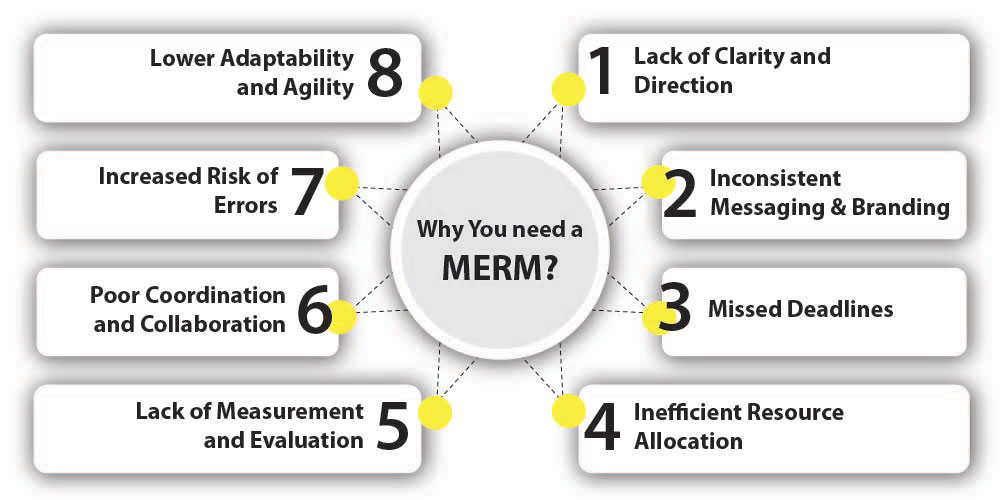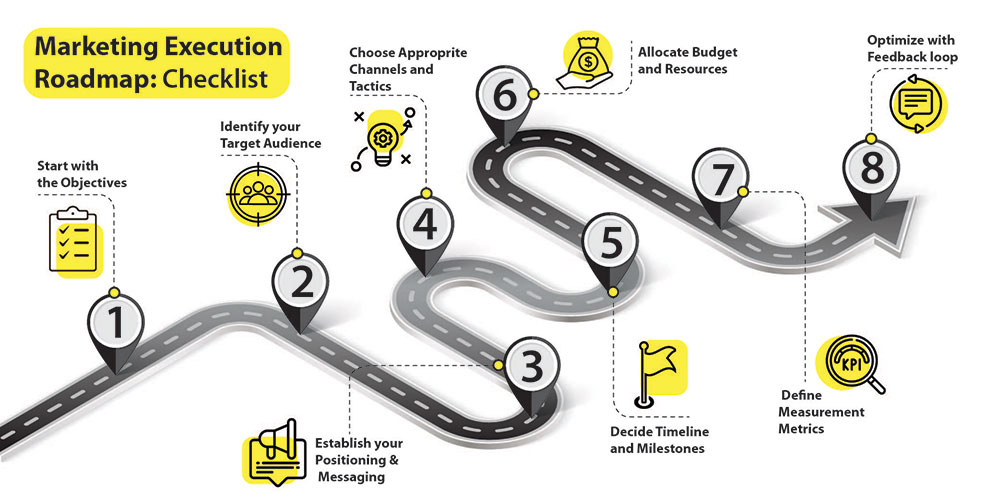The central dogma of marketing revolves around the three ‘R’s:
Delivering the Right messages through the Right medium to the Right people.
Though it may sound straightforward, it’s crucial to acknowledge that every marketing failure can be traced back to a breakdown somewhere within these three ‘R’s.
And, trust us, your business is also susceptible to such failure at any point of time if you don’t have a proper execution roadmap to bring your marketing strategy to life. But what if you have a framework that can streamline everything step by step, lowering the risk of failure. It is possible, and that is what this Review is all about.
The framework we are talking about is called Marketing Execution Road Map or MERM as we commonly refer to it. We have developed this framework to ensure your smooth journey from one R to the second and then the third. After rigorous testing we are highly satisfied and excited about MERM’s capability, and we want to share this with the world so that every business can benefit from it too.
So, without much further ado, let’s have a look at what MERM is, how it is beneficial to your business and how to create one for your own business.
Marketing Execution Road Map: Basic Understanding
A Marketing Execution Road Map or MERM is a strategic document that acts as a bridge between the marketing strategy and the execution team. This document details the precise tasks, deadlines, and resources needed to carry out your marketing efforts. It acts as a manual for marketing teams, especially the content production teams, offering a step-by-step plan to make sure that all marketing initiatives are streamlined with the strategy and carried out effectively.
MERM’s goal is to match marketing initiatives with the overall marketing strategy and vision of the business. It aids in organizing and coordinating a variety of marketing operations, including public relations, content production, social media, and other promotional endeavors to provide a consistent and powerful message to the target audience.
Let us tell you why you should have a Marketing Execution Roadmap.
Why you need a MERM?
Another way of looking at the situation is what may happen if you don’t have a MERM. Here are some possible challenges that you are most likely to face due to the lack of a MERM:

1. Lack of Clarity and Direction:
Without a MERM, marketing teams do not have clear and precise instructions for what should be done, when how and by whom. This leads to confusion, ineffectiveness, and loss of focus. Teams may find it difficult to set priorities for their work and match their initiatives to overarching marketing objectives.
MERM provides a precise guideline of actions, assignee with designated timeline that helps to streamline actions towards a common goal.
2. Inconsistent Messaging and Branding:
Without a MERM, there can be inconsistencies in messaging and branding efforts across various marketing channels. Individual team members may perceive and interpret the messaging differently in the absence of a set guiding document, often leading to a disjointed brand image. The target audience may become confused by inconsistent branding, which will lessen the impact of marketing initiatives.
MERM provides a clear step-by-step instruction and interpretation of those instructions which acts as a common guiding document for everyone in the process.
3. Missed Deadlines:
Setting realistic deadlines and benchmarks for marketing initiatives is made easier with the use of a roadmap. Without a roadmap, there is a greater danger of missing deadlines and experiencing unanticipated delays. Untimely completion of marketing projects could result in missed opportunities, diminished efficacy, and even setbacks for the overall marketing plan.
MERM eradicates the chances of missed deadlines by dividing the entire action into steps that allow businesses to track their progress and make course corrections if necessary.
4. Inefficient Resource Allocation:
It becomes difficult to distribute resources efficiently without a MERM. Without a proper guideline it is difficult for marketing teams to ascertain the proper budget, human, and technological resources needed for each activity. This critical oversight can ultimately pave the way for a cataclysmic chain of events, resulting in the squandering of resources, hampered campaigns, and a devastating lack of funding for essential marketing activities.
With MERM, marketing teams have a predetermined set of activities with a clear estimation of resources for each step.
5. Lack of Measurement and Evaluation:
Marketing endeavors need to be measured and evaluated for their effectiveness, and without a MERM, it will be difficult to determine whether marketing endeavors were successful and to make wise judgments regarding optimization.
MERM often includes KPIs and established criteria to assess the success of marketing initiatives.
6. Poor Coordination and Collaboration:
MERM makes it easier for team members and stakeholders involved in marketing initiatives to coordinate and collaborate. Without a roadmap, teams could have trouble communicating, which could result in misunderstandings and poor alignment. This can undermine teamwork and have a detrimental influence on the general efficacy of marketing initiatives.
MERM provides a clear understanding of responsibility distributions among cross-functional teams that helps them work more efficiently in a collaborative manner.
7. Increased Risk of Errors:
The possibility of mistakes and inconsistencies in marketing activity increases in the absence of a MERM. Without a well-organized strategy, crucial tasks could be missed or performed incorrectly, resulting in mistakes in the content, design, or campaign execution. Inconsistency in messaging and branding can damage the brand’s reputation and have a negative effect on how customers perceive it.
8. Lower Adaptability and Agility:
Without a MERM, marketing teams may struggle to respond effectively to opportunities or difficulties, as the absence of a plan hinders quick adaptation of tactics, strategies, or resources, potentially leading to missed competitive advantages and inadequate risk management.
A MERM increases adaptability and agility by providing a structured and clear plan that outlines objectives, strategies, and timelines. This allows marketing teams to be proactive in responding to changing market conditions and emerging opportunities. Teams can quickly adjust their tactics and resources to stay on track and effectively pivot when necessary, fostering a more nimble and responsive approach to marketing execution.
So, not having a Marketing Execution Roadmap can result in confusion, inefficiency, missed opportunities, and simply a lack of strategic direction for marketing initiatives. But all these can be avoided by simply employing a roadmap.
Let’s learn how.
Marketing Execution Roadmap: Checklist
This is the most exciting part of this Review – because here we provide insights of the incredible MERM framework that we have developed so that you can incorporate the same in your marketing efforts.

So, let’s start:
1. Start with the Objectives:
This is the first thing do- sit with your marketing team and carefully determine the objectives and goals of your marketing initiatives in detail.
Always set SMART (Specific, Measurable, Achievable, Relevant, and Time-bound) objectives and make sure that these objectives in sync with the overall goal and vision of the business.
2. ID your Target Audience:
Marketing campaigns are aimed for your target audience and identifying your target audience is the next box to check. Your marketing communication should be designed in such a way that it addresses the needs, tastes and behaviour of your target audience.
3. Establish your Positioning and Messaging:
Your MERM document needs to clearly state the market positioning for your product/ service. This is important to convey the right messaging to your target audience through your messaging. This section of the MERM document will help you create compelling and consistent messages to highlights the unique value proposition of your product or service to position the brand in the thoughts of the target audience effectively.
4. Choose Appropriate Channels and Tactics:
To reach your target audience you need to determine the best marketing channels and tactics. This could involve both online and offline channels such as social media, email marketing, search engine optimization, content marketing, influencers as well as print media, events, and direct mail.
Your MERM document should clearly mention the desired channels, the reasons for including them, the tactics specific to the platforms that you are going to employ and the specific messaging that you will use on the platform.
Before choosing channels, you need to understand the nature of these channels and how they engage people and align your campaign accordingly.
5. Decide Timeline and Milestones:
The purpose of a roadmap is to complete tasks precisely at the right time. To ensure this, you shall divide your entire planning of the marketing campaign into a few major milestones, including deadlines and start and end dates. Also, mention the required resources for each milestone. This will help with resource management and progress tracking. You can start with a simple spreadsheet along with your MERM document to keep track of things, or for better results, you can also use project management tools for better assortment of tasks and collaboration with the team.
6. Allocate Budget and Resources:
Each of the milestones will require a certain budget and resources to complete. Resources may include personnel of the marketing team, agencies, freelancers, influencers, technology tools, and any other resources required. While deciding the milestones in your MERM document, mention how much budget and what type of internal and external resources will be required for each milestone.
7. Define Measurement Metrics:
Define key performance indicators (KPIs) and metrics to evaluate the marketing campaign’s efficacy. As different channels exhibit distinct user behaviour so you need set up separate KPIs for each channel to monitor the performance of your campaign. Set up tracking systems and analytics tools to track the effectiveness of various marketing efforts and make data-driven decisions.
8.Optimize with Feedback loop:
With the help of KPIs, regularly evaluate the performance of marketing campaigns and make required adjustments and optimizations depending on the information acquired. Learn from the results and use what you’ve learned for future marketing campaigns.
Remember that for the true results, MERM needs to be an ever-evolving document that incorporates changes from the data gathered from feedback.
Conclusion
Marketing is a tricky business, but with the MERM framework, you can streamline and optimize your efforts to land your campaign safely. We’ve developed this framework and we’re excited to see how others use it to their benefit. We’d love your input on how useful you found the MERM concept and if you have any feedback for us.
Please use our comment section for your inputs.





